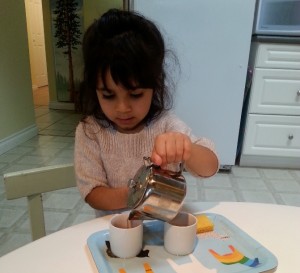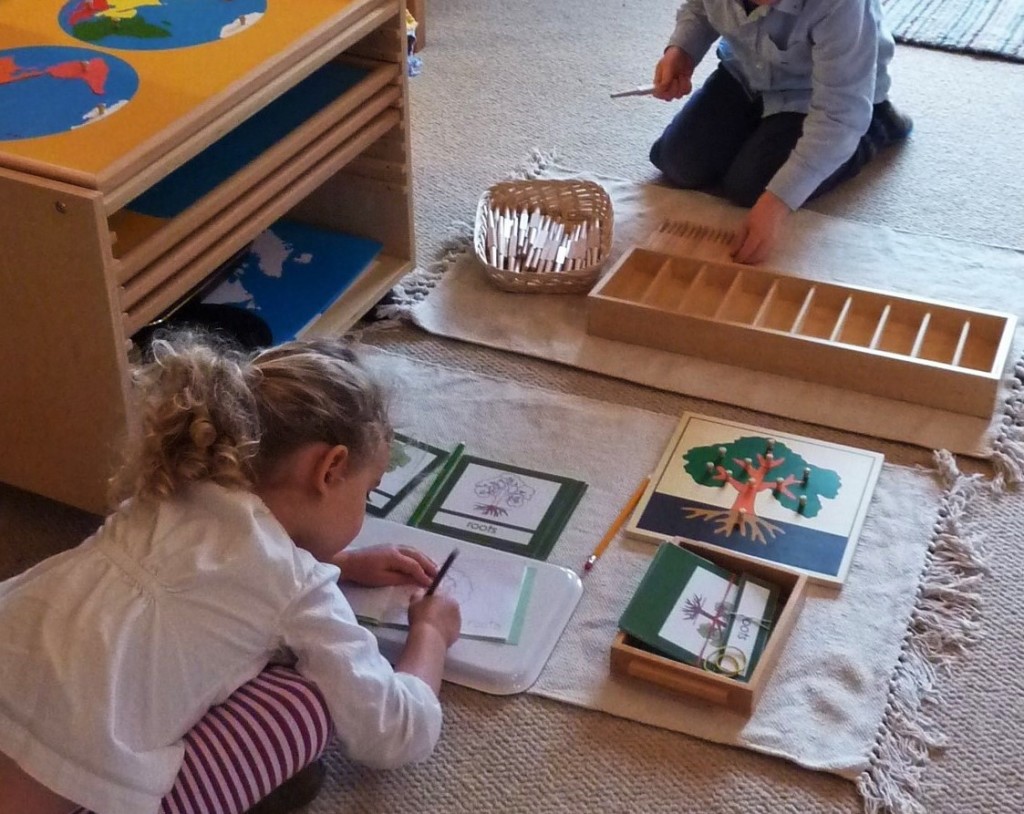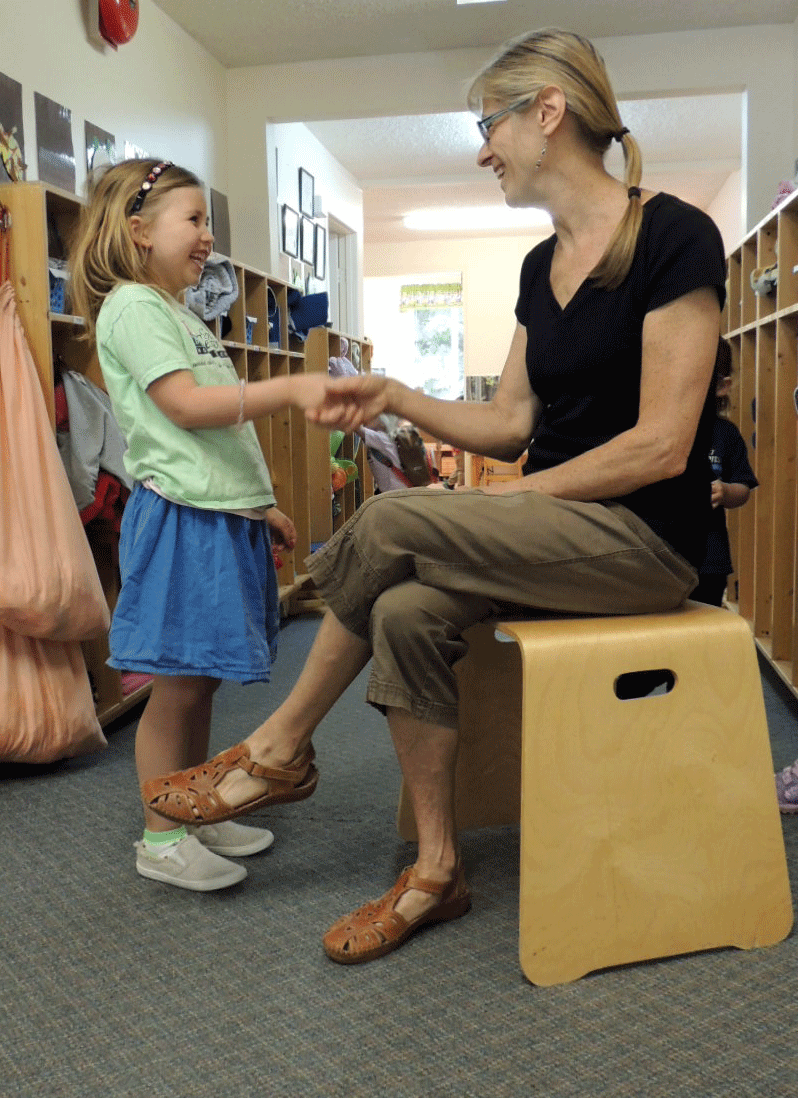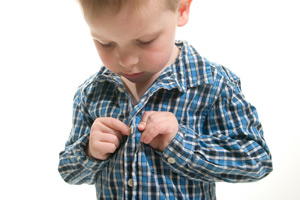The What and Why of Practical Life Exercises
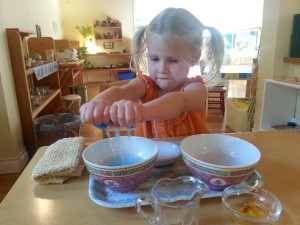 The exercises in Practical Life are the very heart of Montessori education. As young children wash tables, pour liquids, polish silver, sweep and dust, they are developing calmness, order, concentration, coordination, as well as expanding their fine motor skills. At the same time, through the process of learning to meet their own needs, learning to take care of the classroom environment, and through the experience of helping others, children in Montessori programs begin to develop independence, self-confidence, and self-respect.
The exercises in Practical Life are the very heart of Montessori education. As young children wash tables, pour liquids, polish silver, sweep and dust, they are developing calmness, order, concentration, coordination, as well as expanding their fine motor skills. At the same time, through the process of learning to meet their own needs, learning to take care of the classroom environment, and through the experience of helping others, children in Montessori programs begin to develop independence, self-confidence, and self-respect.
 Having watched adults in their environment performing these activities children want to carry them out too. In the Montessori prepared environment, using tools of the right proportions, children can efficiently and effectively perform these tasks. All exercises must be real and not make believe, and they must always be available for the child to use. Tools not toys. The child is introduced to very simple activities at first, such as how to carry a chair, to roll a work mat, to wash their hands etc., only gradually becoming more complex. The activities must reflect the child’s interest and teach her new life skills.
Having watched adults in their environment performing these activities children want to carry them out too. In the Montessori prepared environment, using tools of the right proportions, children can efficiently and effectively perform these tasks. All exercises must be real and not make believe, and they must always be available for the child to use. Tools not toys. The child is introduced to very simple activities at first, such as how to carry a chair, to roll a work mat, to wash their hands etc., only gradually becoming more complex. The activities must reflect the child’s interest and teach her new life skills.
Adults perform these activities to improve the environment, a child does them to improve herself in response to some inner need, it is a process of inner development. Adults do the task once, the quickest and most efficient way, a child will repeat them over and over again, with no short cuts. She is interested in the process, rather than the end result, and in the acquisition of the skill. The child needs to complete the whole activity from start to finish. The freedom to repeat exercises at will, to practice, leads the child to success.
By the acquisition of new skills the child improves hand-eye co-ordination and dexterity and develops spatial awareness. She refines gross and fine motor skills, mental development is aided by satisfying her inner need to grow in self-knowledge and confidence, whilst her self-image improves. The need for order is also satisfied and the child learns about the enjoyment one gets from work completed. His concentration is developed and ultimately through his independence he will gain mastery of the self.
Lessons of the Natural World
The outdoor environment is a natural extension of the Montessori classroom
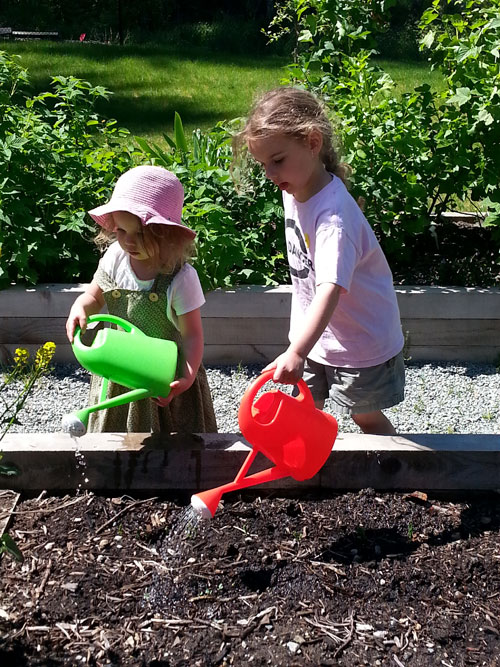 Richard Louv in his book “Last Child in the Woods” coins the term “nature deficit disorder”. He uses this relatively new concept to describe what he sees happening to today’s children as they are increasingly separated from the natural world. He uses contemporary research to show that children have to be in contact with nature for healthy holistic development. That children not only need enough nutritious food and adequate sleep but may also need ongoing contact with nature as well. He feels the free roaming experiences of childhoods past are now too often being replaced by organized, structured “play” experiences.
Richard Louv in his book “Last Child in the Woods” coins the term “nature deficit disorder”. He uses this relatively new concept to describe what he sees happening to today’s children as they are increasingly separated from the natural world. He uses contemporary research to show that children have to be in contact with nature for healthy holistic development. That children not only need enough nutritious food and adequate sleep but may also need ongoing contact with nature as well. He feels the free roaming experiences of childhoods past are now too often being replaced by organized, structured “play” experiences.
More than 100 years ago Dr. Maria Montessori considered the outdoor environment a natural extension of the classroom. Dr. Montessori believed in the importance of young children exploring the world through their senses and felt that through these early experiences the child would develop an understanding of themselves within the context of the natural world. Her ideal of classrooms where the child could naturally move from inside to outside would she felt, allow for the dynamic integration of science and nature into the child’s day. Ultimately this exposure, this wondering and exploration would lead a child to feel love and respect for all living things, including themselves and each other. I feel fortunate to be a Montessori teacher who can provide opportunities for children to explore the natural world, with classroom walls which expand outwards.
New life creates a sense of awe and wonder in all of us and when some Painted Lady caterpillars arrived in the classroom last week the children sat silently while they were introduced at circle time and waited patiently for their turn to look closely at them. The smallness of the caterpillars seemed to create a natural empathy in the children, as they very quietly and gently watched them moving in their containers. Checking on the caterpillars has become part of each morning’s ritual and the children have noticed with amazement how fast the caterpillars have grown. These first hand experiences seemed to excite a real interest in knowing more about the natural world and the lifecycle books, puzzles and activities on the shelves have been much used.
This month each child has had the chance to grow a bean in a jar. It took several days of eager anticipation and careful watering before the first root was seen, but the jars were frequently held, carried around and examined, until finally the little bean seedlings were ready to be transplanted into their own pot of soil and then into their own gardens at home. In our school garden, the children have all helped to prepare the soil and to sow a range of vegetables, from radishes and lettuces to peas and pole beans. What rapidly became obvious was that a child digs in the soil for a different purpose than that of an adult, who wants to get the weeds out and the seeds in as efficiently as possible. A child wants to examine each spider, centipede, worm or wood bug, she wants to feel the soil with her hands, to pour water into the hole she has dug. Planting seeds are interesting to a child but the feel of a wood bugs feet or the slither of a snail across their hand seems to be infinitely more so!
Children are fortunate if they can grow up with access to large gardens, but even the smallest patch of ground can provide natural experiences. Soil quickly can be transformed into a miniature wilderness, where seeds can be watched and tended as they grow into vegetables, grasses or flowers, which will attract butterflies and other winged insects. A pile of scrap lumber, old bricks or rocks left to rot will provide homes for an amazing array of crawling insects. A child’s eye is naturally drawn to the small living, growing things at ground level, whether they are found in a field, a city garden or even a window box or a window sill.
Why does Montessori support a 3 hour work cycle
Montessori schools are often called the Children’s House because everything in them is designed to allow the child to become physically independent; the materials are child sized and the equipment is laid out in an orderly fashion on low shelves that are easily accessible for the children. The equipment is beautiful and well cared for, which encourages the children to take care of it too. Children between the ages of approximately two and a half and six are grouped together in their own mini society. The youngest learn from watching the older children and the older ones benefit by helping those younger than them. The mixed age group allows the children to naturally develop socially, intellectually and emotionally. Continue reading
A Taste of Leadership – The Montessori Kindergarten Year from Four Seasons Montessori
Four Seasons Montessori our sister school in Nanaimo, shared an article about the third Primary Year and the long term benefits the last primary (or Kindergarten) year can bring to the Primary Montessori student.
I have felt fortunate to have shared this experience with many kindergarten aged children over the years and this third year in the Montessori class can offer a very special experience to the child. As the article that follows discusses there are many benefits for the 5 year old child, one that I feel is especially important is the development of their self-esteem. Having watched these children as hesitant 3 year olds and then settled 4 year olds, as 5 year olds they seem to blossom as they move with surety through their day. They know that they can take on any task that they choose, further more they are confident in offering their skills to help other children. Children who stay in the Montessori program for a third year really do seem to naturally become confident, self-motivated, independent and considerate.
To read the full article, follow this link: A Taste of Leadership – The Montessori Kindergarten Year
How A Simple Morning Handshake, Can Impact Your Young Child’s Day.
Consider, for a moment, the start of each school day to be a new beginning. Each morning is a clean slate. Each action you choose can potentially have a powerful and meaningful impact on the day.
Punctuality is a good place to begin; it opens up endless avenues for growth and learning.
When a child consistently arrives at school on time, she/he benefits from the following opportunities:
- To be greeted by the teacher with a handshake and a few words. This simple ritual and personal contact offers the safe and caring transfer of the child from parent to teacher, opening up the opportunity to form attachments and develop new relationships.
- To socialize with peers in the cubby area at arrival time. The sharing of stories from home and the weekend builds communication skills and fosters friendships.
- To get ready by her/himself, including removing and hanging up outdoor clothes and putting on indoor shoes. The children offer each other help and teach their skills in zipping, buttoning, lacing, etc. The independence and cooperation shared as a group empowers the children.
- To transition successfully from home to the classroom environment. Children possess great empathy and are able to console one another on a direct personal level. It might be a simple gesture of one child offering a kind word to another child who is sad, or an invitation by an older child to work with a new student.
- To concentrate and focus on the work with the materials. Children who enter the classroom alongside their peers are more likely to engage and interact in a calm and natural manner, more at ease and confident with their school activities.
Each new day at a Montessori school begins with a ritual unique to the educational method:
The teacher sits on her stool at the school door and greets each child with a handshake, eye contact and a few words. It is a brief exchange of pleasantries during which the teacher might ask a question about the child’s weekend, or pay a compliment on a new haircut. The children gradually transition from the cubby area to the classroom and begin their day by choosing their first work.
To the casual observer, the morning greeting between teacher and child can appear a mere formality. For the educator, there is another important objective: To collect the child. The goal is to make a connection in a friendly way by attracting the child’s eyes, evoking a smile, and, if possible, eliciting a nod. This is the first step in bridging the separation from family. There can now be a transfer of relationship from the parent to the teacher. The child can begin to trust and feel safe in a new environment.
In Hold On to Your Kids, Gordon Neufeld and Gabor Maté discuss the importance of the attachment ritual. They refer to it as the “collecting dance,” a name borrowed from the ancient dance of many cultures that is used to connect people with those they care about. Today, it has become necessary to take this intuitive process to a conscious level as the need for engaging children’s primitive attachment instincts becomes critical in our modern society.
A primary natural instinct of human survival for humans, both young and old, is to resist and be wary of someone who is a stranger to them. A small and vulnerable child will therefore not engage in the learning process until she experiences feelings of emotional and physical security. It becomes imperative then, that an environment of trust, respect, balance and equality is established.
For the Montessori educator, the morning greeting and handshake is an important first step toward this fostering of a safe and secure relationship with her student. This is when the learning process can begin to take place.
Order and routine is at the foundation of the Montessori program
A couple of weeks before Thanksgiving I suggested to my family that we skip the pumpkin pie this year and make something different for dessert. Our pear tree was heavily laden and I couldn’t resist the temptation to bake a pear crumble. Well, the idea was met with groans and disappointed faces. Apparently, I was told, it is a family tradition to bake pumpkin pie and it just wouldn’t be the same without it!
It is a common practice for families to pass down rituals from generation to generation. Some are based in religion; others are treasured cultural customs.
How Independence builds self-worth, motivation, and competence
In the Montessori classroom, independence is an integral part of the day-to-day program. Each morning the cubby area hums with activity as the children get ready for school. It takes practice and persistence to get in and out of coats and shoes. Often a five-year-old, who is ready in a flash, will linger and chat and help a new three-year-old classmate tug at a zipper that won’t go up. In the rush to catch up to friends, the floor might be left with boots and bags strewn about, but it isn’t long before one of the four-year-olds notices and puts everything in order.
Theirs is a classroom that is designed to invite children to take ownership and interest in its use, care and maintenance. Child-sized tables, chairs, shelves and learning materials all promote and stimulate independence. Small hands feel at ease and able to manipulate tools that are made just the right size. It is fun to sweep with the small broom and dustpan – so much fun that sometimes spills happen just for the pure pleasure. Continue reading
What is the 3 year cycle? – Montessori Preschool
“One of the most urgent endeavors to be undertaken on behalf of the reconstruction of society is the reconstruction of education. It must be brought about by giving…children the environment that is adapted to their [nature].”- Maria Montessori
The core framework of the Montessori pedagogy consists of four planes of development: 0-6, 6-12, 12-18, 18-24. From birth to age 6 the infant is forming the child, and from ages 6 to 12 this person consolidates; then from ages 12 to 18 the child is forming the adult, and from ages 18 to 24 this person consolidates. Each plane is divided into two three-year periods, often referred to as 3 year cycles of activity. Continue reading
Bringing Nature Indoors
In the Montessori program children have the opportunity to learn about the physical world, including the language and classification of plants, animals, the landscape, and other features and products of the earth. The no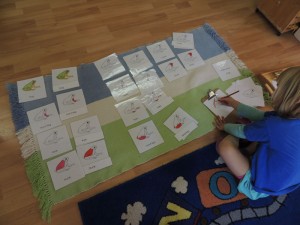 menclature cards and booklets in the cultural area of the classroom illustrate and name the various parts of the tree, leaf, flower, snail and so forth.
menclature cards and booklets in the cultural area of the classroom illustrate and name the various parts of the tree, leaf, flower, snail and so forth.
The work with the nomenclature cards involves matching the illustrations with corresponding labels to learn the names of the parts. For example, the parts of the snail cards depict: Shell, foot, mouth, tentacles, eyespots. Each part is isolated in colour to draw attention to that particular part. Continue reading
Children are Natural Artists
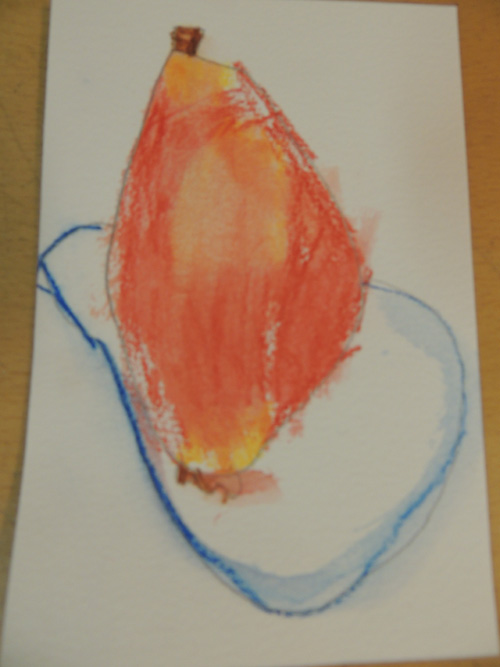 Given paper and a few crayons, the young child finds satisfaction and joy in the creative process, expressing herself with an ease envied by the adult who does not considers themself an artist. For the adult, their work is directed to the end product and is often limited by self-imposed ideas about quality and perfection. The child, on the other hand, is focused only on the process, free from judgment.
Given paper and a few crayons, the young child finds satisfaction and joy in the creative process, expressing herself with an ease envied by the adult who does not considers themself an artist. For the adult, their work is directed to the end product and is often limited by self-imposed ideas about quality and perfection. The child, on the other hand, is focused only on the process, free from judgment.
Observe the three-year old who will sit for long periods of time swirling various colours around and around the page making abstract shapes. The five-year old might paint a picture of her family, their elongated figures with oversized-heads and arms standing under purple clouds and a large yellow sun. Both are pleased.
The child’s artwork is complete when an inner level of development has been reached. Almost without any outward sign, the little artist puts down her crayon or paintbrush and walks away. She is done. She might even forget the picture on the table, or drop it en route to her next activity; she might give the picture away to a friend. There is no attachment to the end product. If there is, it is likely because the child has been requested by an adult to do a painting for them. Continue reading
Sign up to receive new updates from the Blog

